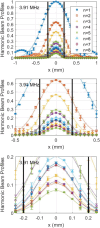Overview of Therapeutic Ultrasound Applications and Safety Considerations: 2024 Update
- PMID: 39526313
- PMCID: PMC11796337
- DOI: 10.1002/jum.16611
Overview of Therapeutic Ultrasound Applications and Safety Considerations: 2024 Update
Abstract
A 2012 review of therapeutic ultrasound was published to educate researchers and physicians on potential applications and concerns for unintended bioeffects (doi: 10.7863/jum.2012.31.4.623). This review serves as an update to the parent article, highlighting advances in therapeutic ultrasound over the past 12 years. In addition to general mechanisms for bioeffects produced by therapeutic ultrasound, current applications, and the pre-clinical and clinical stages are outlined. An overview is provided for image guidance methods to monitor and assess treatment progress. Finally, other topics relevant for the translation of therapeutic ultrasound are discussed, including computational modeling, tissue-mimicking phantoms, and quality assurance protocols.
Keywords: bioeffects; image‐guided therapy; therapeutic ultrasound.
© 2024 The Author(s). Journal of Ultrasound in Medicine published by Wiley Periodicals LLC on behalf of American Institute of Ultrasound in Medicine.
Figures





References
-
- American Institute of Ultrasound in Medicine . Conclusions Regarding Epidemiology for Obstetric Ultrasound. https://www.aium.org/resources/official‐statements/view/conclusions‐rega.... Accessed October 11, 2024.
-
- International Electrotechnical Commission . Particular Requirements for the Basic Safety and Essential Performance of Ultrasonic Medical Diagnostic and Monitoring Equipment. 2.1st ed. IEC; 2015.
-
- American Institute of Ultrasound in Medicine . Recommended Maximum Scanning Times for Displayed Thermal Index (TI) Values. https://www.aium.org/resources/official‐statements/view/recommended‐maxi.... Accessed October 11, 2024. - PubMed
Publication types
MeSH terms
Grants and funding
LinkOut - more resources
Full Text Sources
Medical
Miscellaneous

